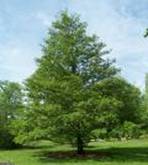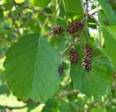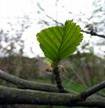| Kingdom | Plantae |
| Division | Magnoliophyta |
| Class | Magnoliopsida |
| Order | Fagales |
| Family | Betulaceae |
| Genus | Alnus |
| Species | A. glutinosa |
| Binomial name | Alnus glutinosa |
Other Common Names:
The other common names for the shrub alder are Black Alder, Common Alder, English Alder, European Alder, Fever Bush, Owler and Winter Berry.
History
Common Alder also sometimes known as Black Alder is a medium sized, fast growing, deciduous native shrub which tends to be an early coloniser of poor and inhospitable sites.

Description
The common alder has an upright, pyramidal growth habit reaching about 50 feet in height. It has lustrous, green bark that becomes brown with age. The deciduous, dark green leaves are shiny above and dull underneath, and turn bright yellow in fall. They are oval in outline with a toothed margin. The catkins, although not particularly colourful, add some interest because of their early appearance, often while snow is on the ground. Throughout the winter the empty cones hang on the branches and from January - March the pale green male catkins stand out, emerging before the leaves, dangling in the wind.


Range
Alder is widely distributed throughout the Caucasus, Europe, Siberia, into Asia Minor, Iran, and North Africa. Naturalized locally in eastern Canada and Northeastern U.S.
Habitat
Alders are a very familiar sight along riverbanks. They thrive on waterlogged soil and their roots help to limit erosion during heavy spates (high, fast flowing water).Its second natural habitat is marshland or boggy ground which it encroaches onto forming woodlands known as alder carr.
Cultivation
The alder is readily propagated by seeds, but throws up root suckers abundantly. Seeds which have remained viable after floating for 12 months are sown at depths of 3-6 mm, in spring or fall. For blanket bogs in England, spot sowings have been recommended ca 15 seeds per spot fertilized with ca 60 g phosphate. Seeds germinate as well under continuous darkness as with normal day lengths. Air-dried seeds stored at 1-2C retained their viability for two years. Seeds can however be sown immediately as soon as ripe. Timber and/or firewood harvested as needed, the shrub apparently coppices readily. In the U.S., it flowers from March to May, the fruits ripening in fall, natural dispersal occurring from late falls to early spring.
Flowering Season
Generally the alder, flowers from March to May.
Pests and Diseases
In the 1990s, a disease (a fungus of the Phytophthora genus, some species of which attack potato crops) destroyed many of the alders beside rivers.
Parts Used


The barks and the leaves of alder are the most commonly used parts of the shrub for its medicinal and commercial purposes.
Medicinal Applications

• The decoction, or distilled water of the leaves, is excellent to treat inflamed or burnt skin and wounds.
• The fresh leaves laid upon swellings dissolve them and stay the inflammations.
• The leaves put under the bare feet galled with travelling are refreshing to the travellers.
• The astringent properties of the alder are used as a gargle for sore throats and pharyngitis.
• The tonic powder got from the bark is used treating dyspepsia.
• Herbalists through the centuries have used brews made from the bark and leaves of the alder as an astringent and a quinine substitute, and to fight inflammations and fevers.
• The leaves and branches also have a reputation as natural pesticides.
• The inner bark, boiled in vinegar and rubbed on the body, reportedly kills lice and scabies mites and dries up scabs.
• Leaves are used to help reduce breast engorgement in nursing mothers.
• In folk remedies it is used for the treatment of cancer of the breast, duodenum, oesophagus, face, pylorus, pancreas, rectum, throat, tongue, and uterus. The bark and/or roots are used for cancers and inflammatory tumours of the throat.
• The bark decoction is taken as a gargle for angina and pharyngitis, as an enema in hematachezia.
• Peasants on the Alps are reported to be frequently cured of rheumatism by being covered with bags full of the heated leaves.
Commercial Applications

• Ash, from alder owing to its great strength under sudden strains, is used for tool handles, spokes and felloes of wheels, and gymnastic apparatus.
• Some better-marked ash is used for making furniture and for other ornamental purposes.
• American ash is much used for making oars and sweeps.
• Hungarian Ash is entirely an ornamental wood, owing to its very twisted grain and the great contrast between the spring and autumn wood in the annual ring. Clogs worn by mill workers farm workers and miners often working in damp conditions in Lancashire and Yorkshire were made from alder wood.
• Alder trees growing along streams were managed by coppicing, and the rods used to shore up banks.
• Alders are coppiced and the wood used to make charcoal especially for gunpowder.
• The astringent nature of the bark is used for tanning and dyeing.
• The species supply natural materials for dyers and tanners and wood for smoking meats and fish and for making pilings used in wet locations.


In Welsh legend alder was associated with the goddess Bran. The hero Gwydion recognised Bran when he saw her carrying alder branches. In Norse legend the first man and woman were made from ash and alder respectively.
Many ancient alders are redundant coppices, the practice having died out in the last 100 years. In Ireland felling alders was punishable because of the apparent ability of the trees to bleed red when cut. Alder, like yew, was a tree associated with death and alder rods would be used to measure corpses and graves. Herbalists and apothecaries used the bark of alder trees for purging: "the country people use it in intermittent fevers with success, because this remedy purges and vomits them vigorously and carries off the disease.